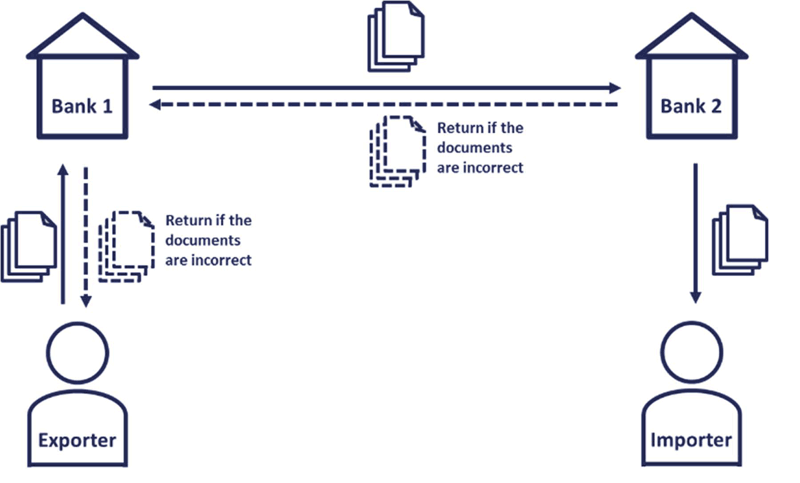by Gilbert Fridgen (Fraunhofer FIT), Bernd Sablowsky (Norddeutsche Landesbank) and Nils Urbach (Fraunhofer FIT)
Blockchain technology offers huge potential to various industries and application areas. In a joint applied research project, Fraunhofer Institute for Applied Information Technology (FIT) together with Norddeutsche Landesbank (NORD/LB) identified (inter-company) workflow management as a promising application area and developed a Blockchain prototype for a documentary letter of credit in the international shipping business. In addition to the project’s explicit outcome – a Blockchain prototype and strategic support for Blockchain innovation management – the joint project revealed important insights into the technology’s applicability in the field.
Norddeutsche Landesbank (NORD/LB) regularly evaluates technology innovations regarding their strategic implications. In this context, NORD/LB, in cooperation with Fraunhofer FIT, started a Blockchain project to identify potential application scenarios and the implementation of a prototype. The aim of the project was to familiarise with Blockchain technology to obtain transferable results for future activities with Blockchain or Distributed Ledger Technology.
A Specific Workflow Management Use-case
Inter-company workflow management is a promising application area for Blockchain technology since requirements of transparency and traceability often demand cumbersome manual processes in today’s businesses. In addition, regulatory requirements can make these processes even worse. Having set the objective to gain as many insights into this application field as possible, the interdisciplinary project team consisting of technology, business, and innovation experts started to analyse one specific use-case in this area. The team identified a banking use-case that is accompanied by plenty of paperwork, which is currently literally sent around the world, e.g., to gather signatures from all relevant process participants. Specifically, the project team implemented a Blockchain prototype of a documentary letter of credit. Simply speaking, a letter of credit is a payment instrument that guarantees an exporter the payment of its goods as long as it fulfils certain conditions such as submitting the correct documents to the corresponding banks. The simplified process is depicted in Figure 1. These documents make the process quite lengthy as they must be sent paper-based from one process participant to the other.

Figure. 1: Document flow in a documentary letter of credit.
Analysing the Disruptive Potential of Blockchain
The project team first discussed the conceptual and technological features of prevailing Blockchain solutions and how these might improve the current state of the process. In particular, Blockchain’s tamper-proof information ‘storage’ ability, thus auditability, could be a major advantage. For example, storing process-related documents in a secure cloud, and hashing their content can provide proof that the original documents have been digitalised and made available to all process participants. As a second step, standardised documents for a letter of credit could be treated fully digitally and would thus completely avoid paper-based documents. Avoiding paper-based documents can reduce costs associated with stationary, postage, and long transportation times.
Transportation time alone (per courier) from one process participant to another can currently take more than two weeks. Furthermore, digital, tamper-proof documents enable parallel processing within single process steps, since the second participant (e.g., bank 2) does not need to wait for the first one (e.g. bank 1) to finish their process step and send the documents on.
Using smart contracts can result in even more important process improvements. A smart contract is a computer program that executes a job if a predefined condition is met. For example, if a stock price drops below a certain level, the share is sold. Within the entire document process (Figure 1), diverse control procedures are necessary as the payment is bound to predefined conditions. Hence, currently bank employees must manually check if these conditions are met. A lot of this work is repetitive and can possibly be implemented using smart contracts with their aforementioned predefined conditions. For example, if a particular shipping date is crucial, this date might be implemented within a smart contract and checked against the date that the shipping is actually accomplished, e.g., when the exporter signs the shipping of goods in the harbour. Then the smart contract is automatically approved if this condition is met - and the next process step is triggered – or rejected if the condition is not met. Hence, a manual process is no longer necessary for such repetitive tasks and the whole processing time can be reduced significantly.
In line with these examples, the implemented prototype puts emphasis on process improvement and ease of use. We make use of the decentral nature of Blockchain systems and include participants of different companies, use smart contracts for process automation, and create a fully digitalised process.
The Project’s Insights
NORD/LB together with Fraunhofer FIT identified a set of potential use-cases for a prototypical implementation that were purposefully different from prevailing cash system use-cases like Bitcoin. In particular, workflow management allows for insights into how to make use of Blockchain properties. Specifically, the tamper-proof ‘storage’ of information as well as process automation using smart contracts were discussed and implemented. Furthermore, the decentralised nature of Blockchain could allow the entire process to be developed in a direction that radically changes or even removes the role of intermediaries (here the banks in Figure 1). Of course, given the early stage of the technology’s development and the current lack of standardisation and legislation this is a glimpse into the future of Blockchain technology and digitalisation, but it is neither far-fetched nor improbable.
Links:
https://kwz.me/Xy
https://kwz.me/XH
Please contact:
Gilbert Fridgen, Nils Urbach
Fraunhofer FIT, Bayreuth, Germany
+49 921 554711, + 49 921 554712
Bernd Sablowsky
Norddeutsche Landesbank, Hannover, Germany
+49 511 3615020











